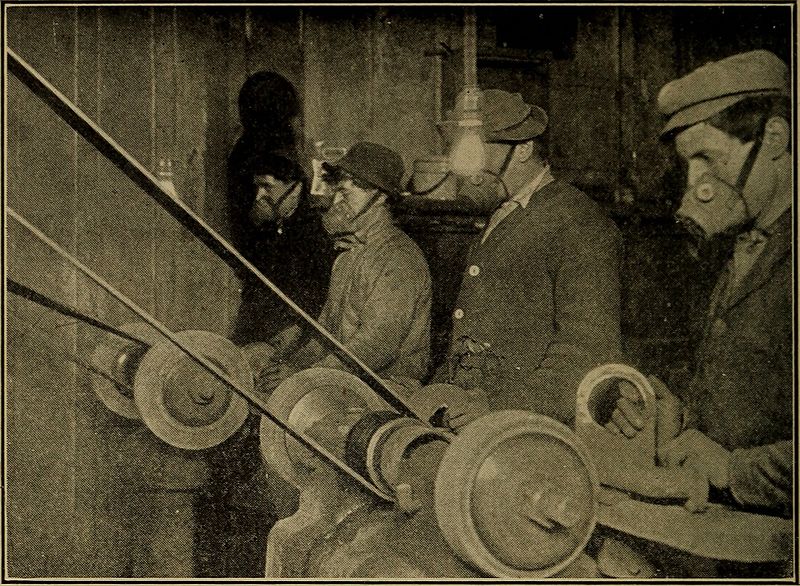For the average American, having a job is an essential aspect of life; without a stable source of income, it is nearly impossible to survive in today’s world. Working during the 1900’s was not as easy it may seem at first look. Although it is true that there were many new jobs available in factories, working in them posed many significant consequences for the employees. Working was more difficult than expected, Americans suffered from working extreme hours around heavy machinery, which made fatalities skyrocket. The government did eventually pass labor laws, but it could not undo the difficulties people had faced.
These laws were meant to maintain the health of workers while providing them safety and compensation for work-related injuries.1 The working conditions of factories produced many hardships for Americans. The pay was barely enough to feed one mouth, so it was rather impossible to feed a whole family. In today’s society, minimum wage employees complain about getting paid $7.25 per hour, but there was no minimum wage in 1900. The average person today works 40 hours per week, which is $290 per week at minimum wages. Most paychecks are handed out every two weeks; therefore, most Americans can make up to $580 in one paycheck. In 1900, the average American worker was paid a measly $400-$500 over the span of a year; this is less than the typical American makes in one paycheck today. Even adjusted for inflation, a higher percentage of Americans lived in poverty then than they do today.2
Although some people believed that only males should hold jobs, there was actually an increasing number of females and children being employed in the workplace. However, the women and children being hired were typically not prepared for career choice jobs, forcing them to work in factories. Factories took advantage of individuals that would work for lower wages without outcry; more often than not, these individuals were comprised of women and children that were desperate for the opportunity to bring any form of income into the household, not realizing that their lower pay may decrease the pay that the father of the house received.3
By 1900, almost 17 percent of females comprised the industrial workforce, most of whom were single and trying to support themselves, their children, or their siblings.4 The women who typically worked were usually white and tended to be under the age of twenty-five; however, a vast majority of workers were the daughters of immigrants or were immigrants themselves.5
The main workplace for women was in the textile industry; this was because most women could not handle the heavy manual labor like men could. In these factories, women typically were paid wages of $6-$8 per week, causing their average income to fall well below the average wages for men. With such a low paycheck, most women found themselves in poverty, and some were forced with no other option besides prostitution.6. Another issue with women working is that society believed that it was wrong for women to be in the workplace and out of the household; so the women who had to take up a job were scrutinized. This view on women working did change over time, with the majority of communities seeing married, employed women as a strong figure, opposed to being the quiet, nurturing, and delicate character that was expected of them.
Due to such low income, most family members were forced to get jobs. This meant that when the man could not solely support the family, women had to step up. When even this did not produce the amount of money needed to sustain the family, children were next in line to find a job. Children that tended to work were often from families whose husbands denied the right for their wives to work; so they helped provide for the family so their mother did not have to work. At least 1.7 million children under the age of sixteen were employed in factories or fields by 1900. About 10% of girls were the age of 10-16 and boys made up 20% of all ages of employed workers.7 Unlike the wives in the textile industry, most children found themselves working in agriculture for an average of twelve hours a day, performing arduous tasks such as picking and hoeing the fields.8 Children in the South usually worked at night, with employers keeping them awake by throwing cold water in their faces. The majority of female children had to cut fruits and vegetables for sixteen hours a day. Even though laws were passed to protect children, they were still vulnerable to getting severely hurt while working; some of these injuries turned fatal quickly.9

Other hardships Americans faced was the amount of hours that made up a typical working day. Most Americans had to work 10-12 hours, six days a week. If they worked in the steel industry, the typical working day consisted of 12 hours.10 The hours may not have seemed so bad, and many of us may have already worked that long for a shift, but the working conditions they were subjected to at the time made it much more difficult. The conditions were labeled as unfit and unhealthy for humans and working for long, exhausting hours did not help reduce the number of injuries. There were several accidents that ended in tragedy, labeling factories as unsafe for working. Although injuries were common, it was very rare for a victim of these on-the-job injuries to receive any type of compensation from their employers or the government. Eventually, workers lost control of the conditions for their labor. With this loss of control, more problems appeared, including already low wages being lowered further and long hours turning longer.
Having a job was never an easy task to maintain in the past. Through the difficult times, Americans did not give up; they fought through the struggles to create a successful life. In the end, one can say the labor challenges were worth the struggle because over time, the United States has significantly improved the laws that we see enacted today that are used to protect all individuals working, as well as protecting children from being subjected to work at young ages.
- “Labor Laws and Regulations,” Monthly Labor Review 7, no. 4 (1918): 240. ↵
- Alan Brinkley. American History: Connecting with the Past Volume 2, 15 edition (New York, NY: McGraw-Hill Education, 2014), 477. ↵
- Alan Brinkley. American History: Connecting with the Past Volume 2, 15 edition (New York, NY: McGraw-Hill Education, 2014), 477. ↵
- Alan Brinkley. American History: Connecting with the Past Volume 2, 15 edition (New York, NY: McGraw-Hill Education, 2014), 477. ↵
- Alan Brinkley, American History: Connecting with the Past Volume 2, 15 edition (New York, NY: McGraw-Hill Education, 2014), 477. ↵
- Alan Brinkley, American History: Connecting with the Past Volume 2, 15 edition (New York, NY: McGraw-Hill Education, 2014), 478 ↵
- Alan Brinkley, American History: Connecting with the Past Volume 2, 15 edition (New York, NY: McGraw-Hill Education, 2014), 478. ↵
- Edward N. Clopper, “The Federal Child Labor Law,” The Elementary School Journal 17, no. 5 (1917): 327. ↵
- Albert J. Beverage, “Child Labor Laws,” The Journal of Education 68, no. 12 (1908): 330. ↵
- Alan Brinkley, American History: Connecting with the Past Volume 2, 15 edition (New York, NY: McGraw-Hill Education, 2014), 477. ↵



46 comments
Andrea Degollado
Before reading this article I had very little knowledge about this topic. It is terrible to read how harsh labor during this time period was on the individual It is sad to read that so many hard workers made 500 a year, if we compare this to today that is no nearly enough money to survive a month if you have a house, and a family.I cannot imagine living in a time where working meant putting your life on the line. This article was very well written and very informative.
Ruben Basaldu
It is easy to see now in our day and age just how easy we really do have it. This article made me realize this because I have a job but the work I do is nothing compared to the labor that these people were going through. This article was very informative in the sense that it made me reflect on my life and how I am living now. This article is sad but this was also just the times. Providing for your family meant that you had to work and sometimes you have to do certain things and work in certain environments to do so. I am glad that work conditions have improved over the years because this is just upsetting.
Chelsea Alvarez
I could not imagine living during a time where going to work meant placing your health and safety at risk. Although I am very glad that labor laws came into place, this does not take away from the fact that many individuals had already experienced the harsh reality of low pay, long hours of extraneous working, and poor working conditions. I really like how pay was included in the article, because it really highlights how overworked and underpaid Americans were during these times. Reading this article really placed things into perspective for me and really shows that the jobs that people hold today have a set of rules that all individuals abide by to not have to experience the harsh conditions of an unsafe work environment.
Alicia Guzman
It is incredibly troubling how harsh labor during this time period was on the spirit of the individual. Not only the fact this it was spirit breaking work it was so difficult to keep a job because if you ever wanted better working conditions or higher wages you would be fired and immediately replaced with someone already taking your place before you left. What a great article about a time with so much despair.
Mariah Garcia
Reading this article made me reflect on my work and how easy I have it compared to the workers in the past. It is sad to read how these hard workers were basically working from paycheck to paycheck because they would only make $400-$500 per year. That is barely enough to make a comfortable living especially if they had children; even the work environment was hostile. I couldn’t imagine working under those conditions. So, I was and now even more grateful for all those people who fought for labor rights.
Emily Jensen
I had very little background information about this topic prior to reading this article, so I was very interested in reading what the author had to say. The comparison of wages between then and now are striking, though I can’t help but wonder what the numbers would look like if the author calculated them taking inflation into consideration instead of just referencing paystubs. An informative article overall.
Tyanne Pearcy
This article touches on a topic that is still very relevant in todays society. Workers has to endure dangerous working conditions, and extensive hours of tiring work just to get paid terribly. It is crazy at some point they had children and women working in these harsh conditions just because they increased productivity. This article shows how much we have evolved since the 1900’s in regards to laws and restrictions in the workplace.
Valeria Perez
Reading these types of articles makes me really grateful to all the people that fought for the rights we take for granted today. I cannot even imagine all the suffering these people must have gone through. This must have been a very chaotic and depressing setting surrounding these people. Work for hours for barely anything and go out to survive. Hope and happiness must have been something only for the wealthy.
Luke Lopez
This was a very interesting article on labor during the 1900’s. It is insane to imagine that people in the 1900’s only earned $400-$500 per year despite working constantly to support themselves and their family. The working conditions were terrible for people at this time, and especially for the children who had to find work because their parents could not make enough money combined to support their family.
Anna Guaderrama
This was such an interesting article and information. However, I felt like it was pretty much just a refresher to me because I had already been taught about this in high school and in community college. At some point I even had two midterm papers over this so, it was alleviating to just read about it for fun. I really enjoyed reading the article, it was written super clearly and In a way that presented the information perfectly.